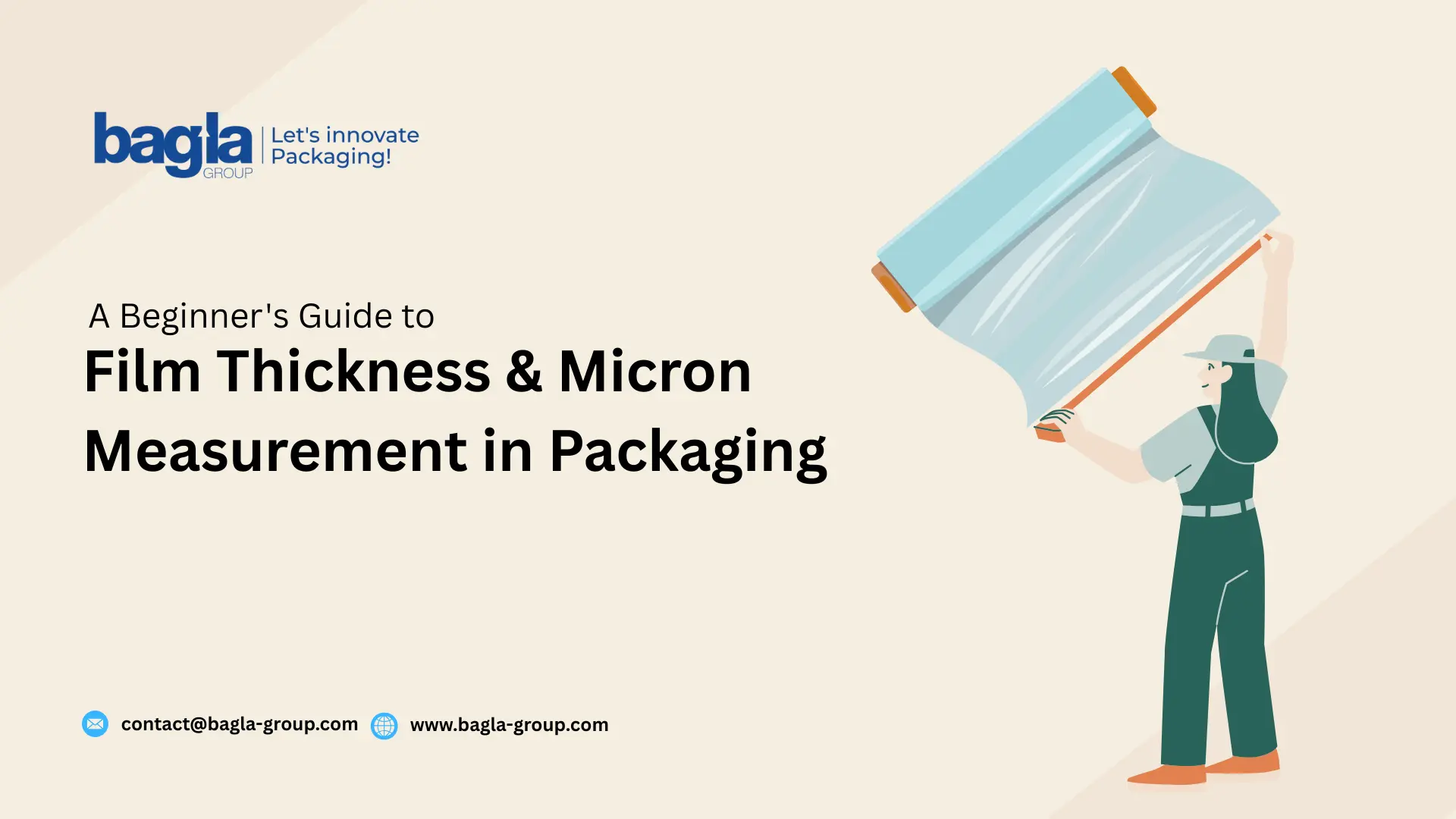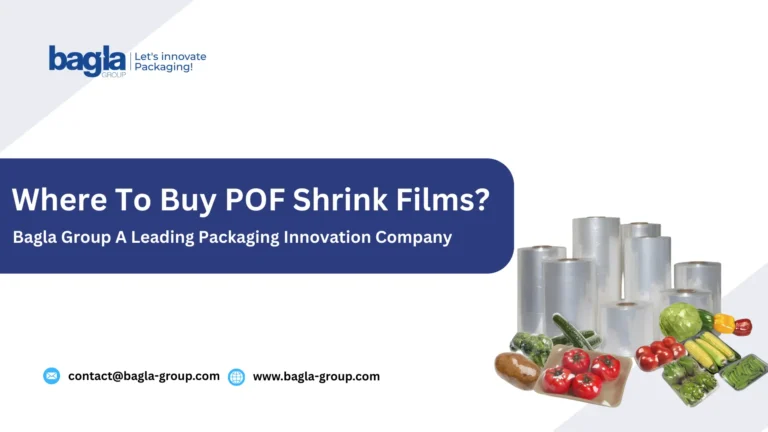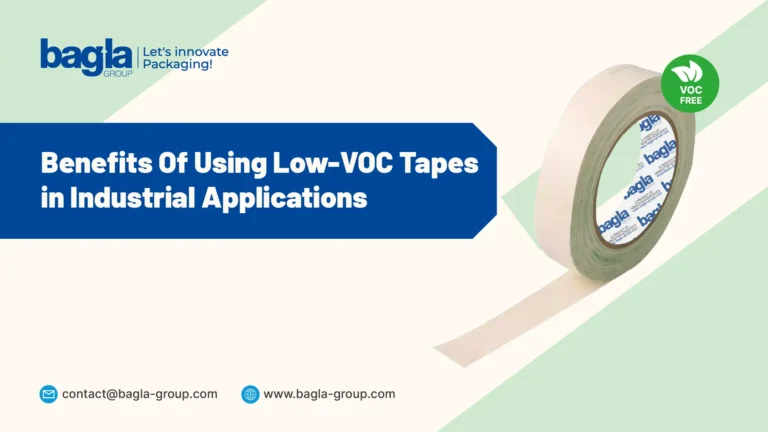When a packer buys packing products, the term that frequently pops up is “Film Thickness”. It happens whether you’re dealing with thermoforming films, shrink films, BOPP tapes, or any other packaging products; understanding film thickness is really helpful. Because the thickness of the packaging product not only affects the strength and durability of the packaging, but it also adds value to performance, cost, and environmental impact.
In this guide, you will walk through the expert advice that will assist you on how to measure Film Thickness and Micron Measurement in Packaging.
What Is Film Thickness?
Film thickness refers to how thin, thick, or flexible a plastic film packaging material is. The film thickness can typically be measured in microns (µ), mils, or gauge, depending on regional standards and the type of film. It directly influences:
- Mechanical strength (tear and puncture resistance)
- Barrier properties (moisture, oxygen, aroma)
- Stretchability and flexibility
- Clarity and gloss
- Sealing performance
Understanding Units of Film Thickness and Micron Measurement in Packaging
There are three common units for film thickness:
| Unit | Symbol | Common Use | Equivalent |
| Micron | µ or µm | Global/Metric System | 1 µ = 0.001 mm = 0.000039 inches |
| Mil | mil | US/Imperial System | 1 mil = 0.001 inches ≈ 25.4 µm |
| Gauge | – | Older US/UK usage | 100 gauge = 1 mil = 25.4 µm |
Conversion Table
| Mil | Micron (µm) | Gauge |
| 1 | 25.4 | 100 |
| 2 | 50.8 | 200 |
| 3 | 76.2 | 300 |
| 4 | 101.6 | 400 |
Most modern packaging companies globally use microns as the standard unit.
Why Film Thickness and Micron Measurement in Packaging Matters?
If you are choosing a packaging product, then you must understand why film thickness and micron measurement in packaging matter to make an effective and efficient decision. The reasons are as follows:
- Product Protection – Thicker films usually offer better resistance to physical impact, abrasion, moisture ingress, and odor transmission.
- Machine Compatibility – Automated packaging machines may have limitations. Films that are too thick or too thin can jam machines, lead to poor sealing, or cause misfeeds.
- Cost Optimization – More thickness means more raw material, and hence, a higher cost. However, overly thin films may compromise product safety, leading to returns or spoilage.
- Environmental Impact – Thicker films use more plastic. With the growing demand for sustainability, many brands opt for thinner, high-performance films with similar barrier properties.
Common Thickness Range in Packaging Films
| Application | Thickness (Microns) |
| Shrink Wrap (Retail) | 12 – 30 µm |
| Lamination Films (Food/FMCG) | 8 – 20 µm |
| Blister Packaging | 100 – 300 µm |
| Vacuum Bags | 70 – 150 µm |
| BOPP Tapes | 36 – 50 µm |
| PE Liners and Sheets | 25 – 150 µm |
| Anti-fog Films (Food Trays) | 20 – 40 µm |
How to Measure Film Thickness and Microns in Packaging?
The film thickness is measured on the following basis:
- Micrometer (Screw Gauge) – A precision tool used manually to measure thickness. Ideal for quality checks and lab testing.
- Digital Thickness Gauge – These devices provide instant digital readings and are more accurate for thin films.
- Online Measurement Systems – Used in factories, these systems measure film thickness in real-time during production using beta gauges, infrared sensors, or capacitive sensors.
Key Terms Related to Film Thickness
| Term | Meaning |
| Nominal Thickness | The average or intended thickness as per design |
| Tolerance | The acceptable deviation in thickness (e.g., ±5%). |
| Gauge Profile | Thickness variation across the width of the film roll. |
| Uniformity | Consistency of thickness throughout the roll. |
A good film should have a tight tolerance and high uniformity.
Film Thickness vs. Film Strength
It is necessary to understand the difference between the film thickness and film strength for packaging.
- Film Thickness – It refers to how thick the packaging film is, such as measuring how fat or thin a plastic sheet is. Film thickness is measured in microns or mils.
- Film Strength – It indicates how strong the film is, how much weight, pressure, or stretch it can handle without tearing.
A thicker film is not always stronger; some thin films are made with stronger materials and can perform better than thicker ones. So, strength depends on the material, not just the thickness.
Advanced materials like multi-layer co-extruded films or nano films can deliver high strength at lower thicknesses.
A 20 µm 5-layer film might perform better than a 30 µm single-layer film. Some 12 µm films with nylon/EVOH layers provide excellent barrier properties. So always focus on performance, not just thickness.
Industry Examples and Use-Cases
With the mentioned information, you can simply understand how you can use the particular film:
- Shrink Films for Food Packaging – Used in fruits, bakery, and multi-pack bundles. Clarity and tight wrapping matter more than excessive strength.
- BOPP Tapes for Carton Sealing – Thicker films are used for heavy-duty boxes; thinner films for lighter packages.
- Vacuum Packaging – Multi-layer films are required to block oxygen and retain aroma.
- Anti-Fog Films – Used in refrigerated food trays. Must be thin yet strong.
Choosing the Right Film Thickness
| Factor | Consideration Example |
| Product weight | Heavier products need thicker films |
| Storage conditions | Frozen or wet items need better seal integrity |
| Shelf life | Longer shelf life = better thermoforming barrier films |
| Packaging speed | Faster machines may need thinner, flexible films |
| Sustainability | Thin, recyclable films are preferred for eco-friendliness |
| Cost constraints | Use optimized thickness to save cost without risk |
How Micron Difference Impact Cost?
Every additional micron increases material usage, weight, and environmental load. For example, in shrink film:
15 µm may cost 20% less than 19 µm, but if the film breaks during packing, the real cost is higher.
Mistakes to Avoid
While choosing the film, you must avoid the following mistakes:
- Assuming thicker = better
- Ignoring tolerance
- Overlooking machine settings
- Choosing one-size-fits-all
Final Thoughts – Film Thickness and Micron Measurement in Packaging
Understanding film thickness and micron measurement empowers you to choose the right films that works as per your product’s packaging requirements. By using the best packaging solution as per the film thickness, you can optimize cost and performance. These types of films ensure product safety, reduce waste, and improve sustainability. So, whether you are a packaging engineer, buyer, or brand owner, you must master and understand these fundamentals of film thickness micron measurement in packaging to enhance your product performance and customer experience.
What Is The Difference Between 20 Micron And 25 Micron Films?
A 25 µm film is 25% thicker than a 20 µm film, offering better strength but at a higher cost.
Can I Use A 12-Micron Film For Heavy-Duty Packaging?
Usually, no. 12 µm films are meant for lightweight retail applications.
What Is A Good Tolerance Range In Film Thickness?
±5% is standard. Premium films may have tighter tolerances.
How Can I Check Film Thickness Myself?
Use a micrometer or digital gauge. For accuracy, lab tools are recommended.
If you are looking for high-performance shrink film as per the suggested thickness, then you can simply consult with the Bagla Group expert team. You will find the best solution as per your product requirements, as Bagla Group is a well-known paper adhesives packaging solution partner. With world-class R&D and manufacturing, Bagla-group helps you strike the perfect balance between strength, cost, and eco-friendliness.



